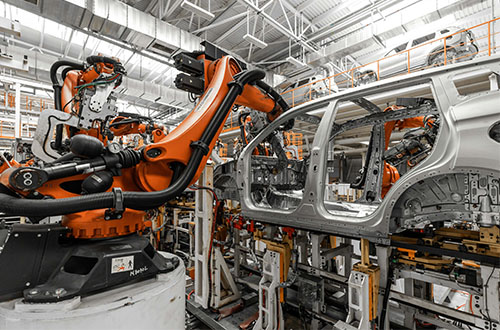

From Assembler to Cloud-Native

The mLogica Migration Team
Modernizing Legacy Applications: The Case for Refactoring
Businesses face growing pressure to modernize their legacy applications, particularly those built on Assembler, to unlock the full potential of cloud computing. Assembler, a low-level programming language critical to many mission-critical systems, remains vital in industries like banking, insurance, and government. Yet, as technology evolves, these legacy systems can limit innovation, scalability, and cost efficiency. Modernizing Assembler applications for cloud environments is now a strategic priority for organizations aiming to stay competitive.
This blog explores the modernization of legacy Assembler applications, highlighting the benefits of refactoring as a transformative approach for long-term success, while recognizing the practical value of replatforming solutions. We see both paths as viable, depending on business needs, but we believe refactoring offers unique advantages for organizations seeking to fully embrace cloud-native capabilities.
Understanding Assembler and Legacy Challenges
Legacy applications powered by Assembler have served businesses reliably for decades, excelling in direct hardware control and low-level operations, making it essential for operating systems, device drivers, and other low-level software. However, their strengths are overshadowed by significant challenges. The dwindling pool of Assembler programmers complicates maintenance and updates, as developers and database administrators familiar with legacy mainframe technology reach retirement age, resulting in a steadily diminishing talent pool. These applications typically run on costly mainframes or outdated hardware that lack the flexibility of modern cloud platforms. Integrating Assembler systems with today’s technologies is also complex and expensive, often resulting in difficult integrations and limited flexibility. As this shortage grows, the costs and risks of relying on Assembler and the mainframes that support them continue to rise, pushing companies to leverage modern environments and practices such as DevOps and the cloud, which were not designed for the limited flexibility and difficult integrations often found in mainframe systems. These obstacles push organizations toward modernization, with refactoring emerging as a transformative solution that not only migrates but also future proofs these systems.
The need for modernization is driven by the diminishing talent pool, as developers and database administrators familiar with legacy mainframe technology reach retirement age, resulting in a steadily diminishing talent pool. As this shortage grows, the costs and risks of relying on Assembler and the mainframes that support them continue to rise, pushing companies to leverage modern environments and practices such as DevOps and the cloud, which were not designed for the limited flexibility and difficult integrations often found in mainframe systems.
What Makes an Architecture Cloud-Native?
Cloud-native architectures are designed to thrive in the cloud, delivering unmatched scalability, resilience, and agility. They rely on breaking down monolithic applications into smaller, independent microservices that can be developed and scaled separately, packaging applications with tools like Docker for consistency across environments, managing containers with platforms like Kubernetes for seamless deployment, and streamlining development through DevOps practices like continuous integration and delivery. The rewards are substantial: resources adjust dynamically to meet demand, built-in redundancy boosts reliability, faster development cycles speed up market delivery and pay-as-you-go models cut operational costs. Achieving these benefits often requires significant changes, making the choice between rehosting and refactoring a defining moment.
Cloud-native migration paves the way for faster time-to-market, improved customer experiences, and reduced operational costs, but the path is riddled with complexities, requiring careful planning, robust strategies, and an in-depth understanding of both legacy systems and modern cloud-native paradigms. The process involves containerization, which offers scalability, isolation, and portability, and DevOps practices, such as infrastructure as code, continuous integration, and automated testing, essential components of cloud-native development.
Rehosting is a Quick but Limited Path to the Cloud
Rehosting, commonly known as “lift and shift,” involves moving an Assembler application to the cloud with minimal changes, typically using emulation or virtualization to run it as it did on the original hardware. This approach is the fastest migration path, often completed in weeks, and keeps the original code intact to minimize the risk of errors. It’s also cost-effective upfront compared to refactoring.
However, rehosted applications miss out on cloud-native features like dynamic scaling or microservices, which can lead to performance bottlenecks or latency issues without optimization. Emulation tools may also tie businesses to specific cloud providers, creating vendor dependency. Rehosting makes sense for quickly exiting aging hardware, reducing infrastructure costs, or for stable applications that don’t need frequent updates. It can also serve as a first step in a phased modernization plan, with refactoring to follow.
The rehosting strategy is part of the broader cloud migration approaches, often referred to as one of the “7 Rs” by Gartner, which include rehosting, redeployment, repackaging, refactoring, repurchasing, retiring, and retaining. Rehosting is particularly suitable for organizations looking to transfer applications to the cloud with some optimization to benefit from cloud capabilities, but without significant architectural changes. However, it often leaves organizations with applications that are still tied to legacy architectures limiting their ability to innovate and scale, making it a less strategic choice for long-term growth.
Refactoring is Building for the Long Term
Refactoring an Assembler application to make it cloud-native often involves rewriting it in modern languages like Java and adopting microservices. This transformation fully leverages cloud capabilities, providing scalability, performance, and flexibility. Automated tools can convert Assembler code to modern languages while preserving business logic, making the process more efficient and less error prone. Refactored applications not only run on the cloud but are designed to take full advantage of cloud-native features, such as containerization with Docker, orchestration with Kubernetes, and DevOps practices for continuous integration and delivery. This approach eliminates technical debt, attracts a wider pool of developers familiar with modern languages, and prepares the system for ongoing innovation.
Refactoring can take different forms:
- Manual rewrite of code converts Assembler code line-by-line to a modern language, though it is error-prone, time consuming; projects generally run behind schedule, over budget and in many cases, fail completely.
- Automated conversion of Assembler code to a modern language, which is faster, error free and scalable to handle large deployments without any code freeze.
As an example, mLogica’s LIBER*M migration suite, powered by advanced AI technology, converts and reorganizes code into modern design patterns, achieving up to 90%+ automation. While refactoring might require more time and expertise upfront, its long-term benefits are substantial.
Organizations can achieve up to 50% cost reduction by moving away from mainframe hardware, as demonstrated in various case studies, where they also reported improved performance and enhanced scalability through cloud services. Refactoring is another of the “7 Rs” strategies, involving transforming an application to a more modern technology and leveraging cloud-native features to enhance agility, performance, and scalability, usually involving porting the operating system and database. This approach is particularly beneficial for organizations looking to modernize their applications to meet current business requirements, reduce costs, and allow for deeper integration with modern systems.
Comparing Rehosting and Refactoring
The decision to rehost or refactor hinges on an organization’s priorities, application complexity, and resources. Rehosting is faster and cheaper initially, often taking weeks to months, but it may lead to higher costs over time due to limited cloud optimization and carries forward existing technical debt. Refactoring requires a larger upfront investment but can take months rather than years, and it delivers long-term savings, performance gains, and adaptability to future technologies. Rehosting may not enhance user experience or business agility, while refactoring unlocks new features and better performance, though it risks temporary disruptions.
When deciding between rehosting and refactoring, organizations must weigh their immediate needs against long-term goals. Rehosting is ideal for quickly exiting aging hardware or reducing infrastructure costs with minimal disruption. However, it often leaves applications tied to legacy architectures, limiting their ability to innovate and scale. Refactoring, while more complex and time-consuming initially, provides a foundation for future growth. It transforms applications into modern, cloud-native systems that are scalable, resilient, and agile. For businesses committed to digital transformation, refactoring is often the preferred choice, as it not only migrates the application to the cloud but also modernizes it, aligning with current best practices and preparing it for future innovations.
The migration process itself presents security risks, particularly when transferring large volumes of data, which may be sensitive, and configuring access controls for applications across different environments, creating significant exposure. Organizations must consider which migration strategy best answers their needs, balancing the need for speed and low risk with the desire for long-term scalability and innovation, with the evidence leaning toward refactoring for organizations focused on digital transformation.
Real-World Modernization Success
Many organizations have successfully modernized their legacy Assembler applications by refactoring them to modern languages like Java. One such case involved the mLogica migration team migrating from a large-scale banking system from Assembler to Java, resulting in a 60% reduction in operational costs and a 30% improvement in transaction processing speed. The refactored application was designed using microservices and hosted on a cloud platform, allowing for greater scalability and easier maintenance.
Another example is from the insurance sector, where the mLogica migration team refactored the customer’s Assembler-based policy management system to Java, enabling seamless integration with modern APIs and improving data analytics capabilities. This transformation not only reduced the total cost of ownership but also enhanced the system’s ability to handle complex queries and provide real-time insights.
These case studies demonstrate that refactoring legacy Assembler applications can lead to significant cost savings, performance improvements, and strategic advantages, making it a worthwhile investment for organizations looking to stay competitive in the digital age.
Best Practices for a Seamless Migration
To ensure a successful migration, organizations should take a thoughtful approach. Start by assessing applications thoroughly with code analysis tools to evaluate complexity and modernization potential. Aligning the strategy with budget, timeline, and scalability goals, a hybrid approach, rehosting now and refactoring later, may be effective for some. Leverage automation tools to streamline migration and reduce errors. Prioritize robust data migration and security protocols to protect sensitive information, given the security risks involved in transferring large volumes of data. Develop comprehensive testing strategies and use CI/CD pipelines for smooth deployment. Finally, invest in training developers in modern languages and cloud technologies to support ongoing maintenance and innovation, addressing the diminishing talent pool in legacy technologies.
Embracing the Future Through Refactoring
Migrating legacy Assembler applications to cloud-native architectures is a complex but essential step for businesses aiming to stay competitive. While rehosting offers a quick, low-risk path to the cloud, it often falls short in providing the scalability and innovation potential that cloud-native architectures promise. Refactoring delivers long-term benefits by fully leveraging cloud capabilities and modernizing applications. For organizations looking to future-proof their IT infrastructure and drive continuous innovation, mLogica’s LIBER*M refactoring software is the strategic choice. By carefully assessing their applications, leveraging automated tools, and following best practices, companies can successfully transform their legacy systems into powerful, scalable assets that support growth and agility in the digital age, with research suggesting it can boost scalability and innovation, and real-world examples showing significant cost and performance gains.








































